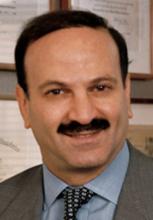SEOUL, SOUTH KOREA – Ablative fractional resurfacing with a 30-W carbon dioxide laser is a safe and effective therapy for atrophic scarring due to surgery or trauma, according to a prospective study featuring quantitative assessment of improvement in scar depth and volume.
"We’re now using this routinely on the surgical side of our practice," Dr. Roy G. Geronemus said at the World Congress of Dermatology.
He presented a study of 12 women with 19 nonacne atrophic scars, each of whom underwent three ablative fractional resurfacing (AFR) sessions at 1- to 4-month intervals. Follow-up continued for another 6 months after the final treatment, with grading of adverse events and efficacy provided both by patients and by nonblinded investigators.
The study also featured quantitative measurements of volumetric scar improvement using the Primos Imaging three-dimensional optical profiling system, which generates high-resolution topographic images of cutaneous scars. That’s a particularly noteworthy aspect of the study. The field of cosmetic dermatology is often heavily criticized for a glaring absence of this sort of objective before-and-after data.
The laser used to achieve AFR in this study was Solta Medical’s Fraxel re:pair Laser. The device delivers a pixelated pattern of microscopic ablative wounds surrounded by healthy tissue. This pattern results in zones of thermal coagulation and tissue ablation that run much deeper than those obtainable with traditional CO2 laser ablative resurfacing. This leads to more impressive neocollagenesis and dermal remodeling accompanied by shorter healing times and better safety than can be obtained with traditional broad-stroke ablative resurfacing, said Dr. Geronemus, medical director of the Laser and Skin Surgery Center of New York.
At the 6-month follow-up visit, Primos Imaging analysis demonstrated a mean 38% reduction in scar volume and a 36% decrease in maximum scar depth, compared with baseline.
Mean patient and investigator scores indicated a moderate 26%-50% improvement in scar texture, atrophy, and pigmentation. Patients and investigators respectively characterized 63% and 89% of scars as showing a 51% or greater overall improvement. A 76% or greater overall improvement was achieved in 42% and 16% of treated scars, according to patients and investigators, respectively.
Treatment-related erythema was typically rated moderate to severe, and it peaked at 72 hours after each treatment session, dropping to mild to moderate by 1 week. Edema peaked at a mild to moderate level within an hour post treatment. No incidents of delayed-onset hypopigmentation occurred during 6 months of post-AFR follow-up; in contrast, this complication has been noted in 20% or more of patients following traditional CO2 laser resurfacing, the dermatologist noted.
As to the AFR treatment settings, facial scars were typically addressed at 70 mJ per pulse, an energy density of 200 microscopic treatment zones/cm2 per pass, and 2-3 passes per session, resulting in 27%-38% coverage. Scars on the body were best addressed at 40 mJ per pulse, 200 microscopic treatment zones/cm2 per pass, and 2-3 passes, for 20%-30% coverage. Higher fluences off-face appeared to be more effective but brought prolonged erythema, which many patients find objectionable.
In an earlier study, Dr. Geronemus and his coworkers showed that the same CO2 AFR laser was effective for treatment of acne scars, achieving a mean 67% improvement in scar depth as measured using the Primos Imaging system (Lasers Surg. Med. 2008;40:381-6).
Dr. Geronemus is a shareholder in Solta Medical, and is on the advisory boards of numerous dermatologic laser manufacturers.


